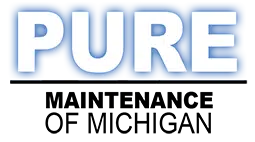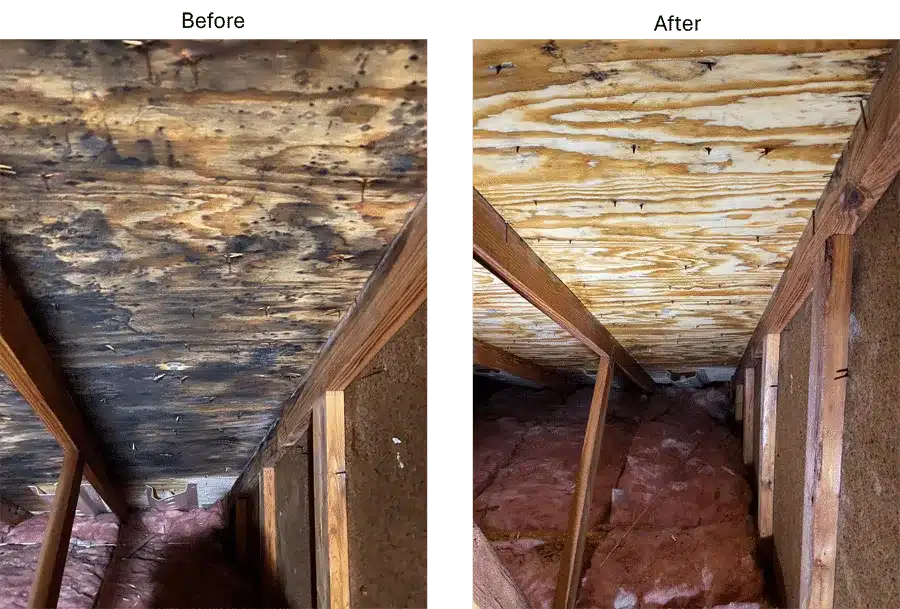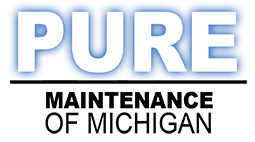Selling a West Bloomfield House With Mold – Mold Remediation Needed
In West Bloomfield, Michigan, a homeowner discovered mold in their attic during a home inspection prompted by their intention to sell the house.
The attic lacked proper ventilation, exacerbating the mold growth, and therefore needed a mold remediation service.
The issue stemmed from a leak in the roof combined with poor airflow, creating an environment conducive to mold proliferation. The house, a 1980s design without a ridge vent, contributed to the problem.
The mold remediation process involved using InstaPURE, a dry fog solution containing industrial-strength hydrogen peroxide and vinegar, to kill the mold.
This solution was dispersed throughout the attic to eliminate mold spores in the air and on surfaces.
The subsequent step involved using MMR or Avenger solution, applied with a wand similar to jet washing, to remove mold stains.
This process did not require the occupants to vacate the house, and the chemicals dissipated after approximately 40 minutes.
The remediation effort was thorough, involving meticulous cleaning of the affected surfaces. Despite the challenging labor involved, the project was completed within a day, with two hours allocated for mold killing and an additional six hours for mold removal.
The decision to visually remove the mold was influenced by the home inspector’s recommendation and the realtor’s obligation to disclose the issue to potential buyers. Overall, the remediation effort was successful, restoring the attic to a mold-free condition and ensuring compliance with inspection standards.
Mold Remediation West Bloomfield Attic – Best Low Cost Effective – Case Study
Mold Remediation in a West Bloomfield Attic – Video Transcription
Tim: Alright, so, yeah, well tell me about it. So, so what happened? You presumably got a call from somebody in West Bloomfield?
Scott: I got a call from the owner and they were, trying to sell the house and the home inspection revealed that they had mold in the attic, uh, poorly ventilated attic. So they called me for mold remediation.
Tim: They had a home inspection done?
Scott: Correct? Yes.
Scott: The home inspector, obviously discovered that they had a huge mold issue up in their attic.
$600,000 1980 House With Black Mold – But How Come?
Tim: So what type of a house was it?
Scott: It was a 1980s, designed house that did not have a ridge vent on the top of the roof.
Tim: Oh wow. So isn’t that like going against code?
Scott: Uh, not back in the eighties, no.
Tim: Huh, that’s So I’m surprised, given that the house was that recently built, they got a mold issue, is that comment correct?
Scott: Usually if a house has a ridge vent, it’s not common unless they have a leak, but because of the poor ventilation, it’s very common for an attic like that. They had a leak and basically it’s like a Petri dish just, just staying, up in the attic without any air exchange. So the mold had free reign to, to attach itself to a majority of the attic.
Tim: So was it to do with the vent or was it actually that the roof was leaking?
Scott: The roof was leaking, but if you have like a ridge vent and two side vents, it gives you some air exchange. So the mold can’t attach itself because the air is flowing back and forth. But when the air becomes stagnant, that’s basically just an environment for the mold to grow.
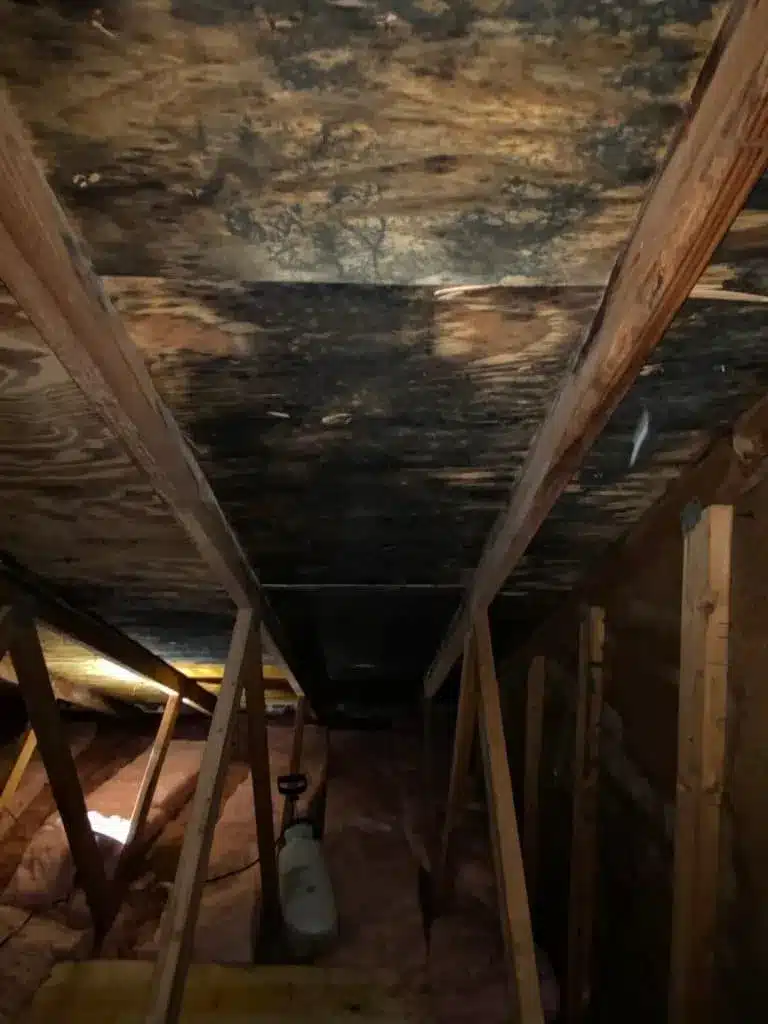
Yep. So that area right there is the infected area before remediation. remediation will kill all the mold in the air and on all surfaces.
Can You Sell a House that has Horrible Unhealthy Black Mold?
Tim: So, so I can’t believe how, that’s seriously black mold. It looks awful.
Scott: Oh, it’s, it’s, it’s very typical of a, of an unvented attic.
Tim: I’m surprised they didn’t have to replace all the wood.
Scott: No, no, no, not at all. It, it was, it was just basically surface mold surface that had grown there. It didn’t deteriorate the wood whatsoever.
Tim: So, so help me understand, they had a leak, but did they not notice they had a leak? It couldn’t have leaked very much. It was just a little bit maybe, or what was the deal?
Scott: It was a leak and the roofer said that it was fixed, and I believe there was some ice damming involved and they didn’t pay any more heed to that besides taking the word of the roofer.
Tim: Right. So, they didn’t, when they realized they had a leak, presumably, it was coming into the house, they didn’t look in the attic or…
Scott: No, the, the leak was there. They fixed the patch, but the the mold that had occurred about five years previous. Oh, so the entryway into that space in the attic was through the bedroom and nobody took, you know, any initiative to, to check and see how the, the attic itself was doing.
Tim: What kind of, what kind of house? size or, you know, just your guess as to what kind of, you know, the value of the house? Was it like a big expensive house or was it a small, you know, three bedroom or? Can you describe it a little bit?
Scott: Uh, it was a two-level house, probably about 3,200 square feet. And it had some high gables to it. The pitch was a little steeper. And, you know, it still, it was still a, a very modern designed house. It was well-kept, it just wasn’t. So
Tim: Was it your typical $300,000 house? $400, $500? What sort of ballpark are we in, roughly would you guess?
Scott: In West Bloomfield, probably $600,000.
Tim: Oh wow. Easily. Is West Bloomfield a posh area then?
Scott: It’s the second-highest-grossing area in Detroit besides Birmingham.
Tim: Huh! I didn’t know that.
Tim: That’s what I was gonna ask you next. Where about is West Bloomfield? I don’t think I’ve ever been there.
Scott: It’s a little north of Detroit. It’s where all the sports stars live, Birmingham and West Bloomfield.
Tim: Oh, is it? Wow.
Scott: Yep, yep. All, all the hockey players live there. Matthew Stafford lived there. It’s, it’s pretty posh.
Tim: So. Okay, so we’ve got the images. So, um, tell me, what image you want me to click on? And I’ll open it and you can just talk through kind of what, what happened and what you did and stuff.
Scott: Probably the top right or top left, excuse me.
Tim: So we’ll start there and go through.
Scott: Sure.
Tim: Okay. So that’s the one that we’re on?
Scott: Yep. So that area right there is the infected area before remediation,
Tim: Uhhuh <affirmative>.
Scott: Now the difference is, is that remediation will kill all the mold in the air and on all surfaces. That is the staining of the mold itself. So it’s two different projects. The first one is to kill all the mold, which was done, and because the home inspector wanted it visually removed, that’s a whole different step.
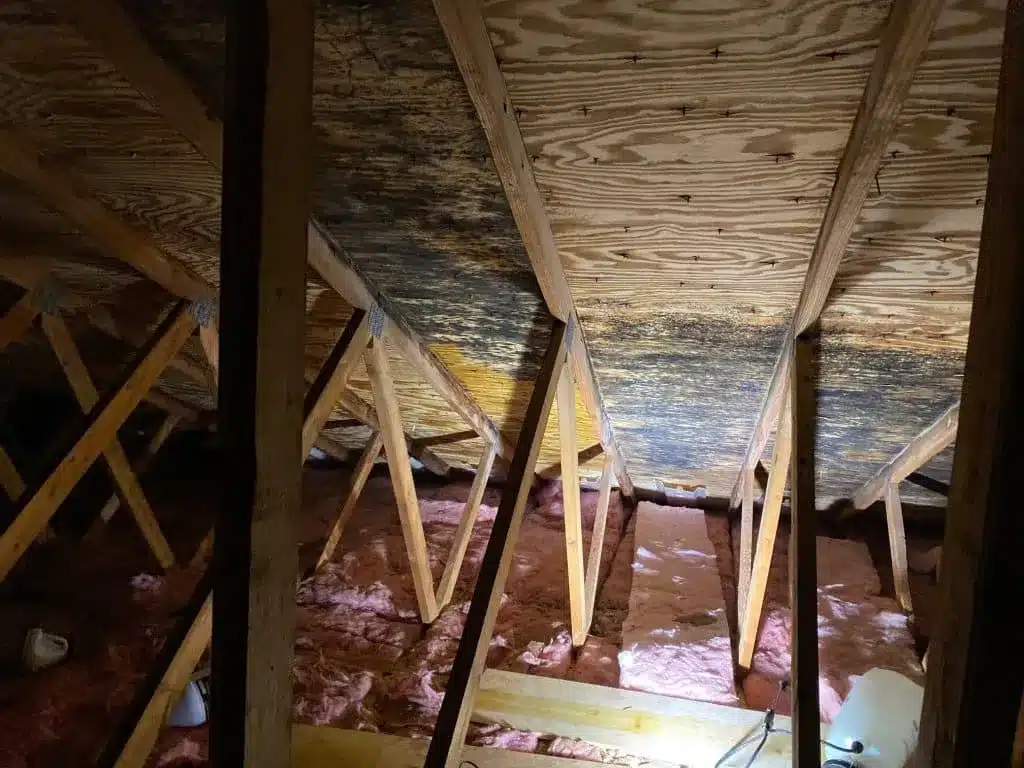
Mold remediation will kill all the mold in the air and on all surfaces. This image shows the staining of the mold itself. Mold remediation will kill all the mold. Mold Clean-up will remove the now harmless black staining.
Mold Remediation Before and After
Tim: So that picture was after the mold had been killed?
Scott: Correct. It’s right, for lack of a better word, it’s like leaving dead bodies stacked up <laugh>.
Tim: But do the dead bodies stink or is it, you know, at that point?
Scott: No, it’s not. It’s dead. Nope, smells fine.
Tim: So it’s not gonna, because I mean, a dead body is gonna smell, right?
Scott: Correct, yes. You’re the first person to ever say that to me, but yes,
Tim: <laugh>. Okay, go ahead. So,
Scott: You know, gen generally 85% of your mold is floating in the air and 15% of it, it’s looking to attach itself to a surface.
Tim: Uhhuh
Scott: With the inadequate ventilation going on in that attic space, there obviously was mold floating around and because of that leak, it attached itself to the surface and just started spreading. And once it spreads, it, it’s, it’s pretty much going to run throughout the whole basement, or excuse me, the whole attic.
Black Mold – Stachybotrys and Penicillin Aspergillus
Tim: So isn’t black mold the one that’s really unhealthy?
Scott: Well, the most molds have different colors. Black mold is really a euphemism for what they call micro-toxic mold. Okay. Microtoxin mold is, uh, two different molds are that are the, probably the most common are Stachybotrys and Chaetomium. That attic had a very high count of Stachybotrys and Penicillium Aspergillus. So not only was mold in the attic, it was unhealthy mold, in itself.
Tim: Was it able to be detected in the house? Was it, was it, or was it contained in the attic?
Scott: That was contained in the attic. The rest of the house was tested, that was tested by an independent tester. I did not do the testing right. The rest was mold free with the exception of that attic.
InstaPURE Dry Fog – Hydrogen Peroxide and Vinegar
Tim: Okay. So what’s the process then to, get rid of the mold?
Scott: So what we do is we use, a dry fog called InstaPURE. Mm-Hmm <affirmative>, it’s industrial strength, hydrogen peroxide and vinegar. It’s EPA-approved green and a mold cell is basically made out of a starch and sugar. What we do is we blast that InstaPURE within the whole, structure and the environment, and what it does is it eats away at that mold cell and it collapses in on itself. So it kills everything that’s in the air and everything that’s on the surfaces. So what you’re looking at is dead mold at this point.
Tim: How long does the process take to do that? I mean, what, what’s involved? So you go up there with a big machine or what do you do?
Blasting the MOLD
Scott: So we’ve got, we’ve got a tank that holds the, the solution and we have generators. We have a long, tube that’s attached to two heads. Those heads will spray, up to 0.7 microns in size, which is about 20 times smaller than a mold cell that get, that gets blasted into the area itself. There’s basically a mathematical equation of the square footage versus the ceiling height. So most houses are based on an eight-foot ceiling and the square footage, an attic with that pitch, um, is definitely different than an attic that would be at like a six-twelve pitch. There’s more space to take up with that fog. So it took a little longer because we had higher gables. But something like that generally takes about two hours and we perform an after-test to make sure the levels are at healthy levels, uh, for human consumption. <inaudible
Tim: Is that before and after?
Scott: Correct.
Tim: So, so it’s the same image before and after. Wow. That has really come away. How can you possibly go about removing all that black stain? I mean, with all, you can’t rub it or sand it ’cause of all the nails sticking through. How does that work?
Mold Remediation – The Clean-up Process

Tim: So it’s like, it’s like jet washing, is it, it’s
Scott: Exactly like jet washing. Yep.
Tim: So what happens, I mean, that’s gonna push a whole bunch of liquid onto the roof. Doesn’t it make all the insulation and the floor wet?
Scott: It does, uh, I mean it’s, it’s not very prevalent. Majority. I mean, you, you adjust the spray so it pretty much clings to the plywood itself, but you will get some seepage and drippage, yes.
Tim: Oh, so you’re not gonna end up with a soggy soaky floor sinking through to the ceiling or anything?
Scott: No, no. Just a very acute bleach smell.
Tim: So is it, is this process, intrusive to the house at all?
Scott: The clients can be right there. They don’t need to vacate the house. If we were remediating a house, they would have to vacate, but because it’s an attic, the smell and the chemicals dissipate after 40 minutes.
Tim: Right. And is, is that, is that the equipment for the solution that that cleaned it?
Scott: Yes.
Tim: Cool. So again, that’s before
Scott: Yep.
Tim: And you, well, uh, this is like, this is where you’ve cleaned and this is where you’ve gotta clean, is it? Yeah.
Scott: Kind of did a checkerboard so you could see the difference.
Tim: Yeah, that’s pretty dramatic, huh?
Scott: That, that one, that one took a lot of product. That was really bad.
Tim: Big surface area.
Scott: Yeah. Huge.
Tim: And you’d definitely want that removed. You’d hesitate to buy a house with all that in it, right?
Scott: <laugh>? Absolutely.
Tim: Yeah. So, where I have in, I, I’ve got a loft over the garage and we had insulation put over, um, the roof, the pitch of the roof, and we had those run all the way up, uh, and it’s vented at the top. So that’s the right way to do it?
Scott: Correct. Generally mold won’t grow on fiberglass because it’s not an organic material, it’s basically glass. Ah,
Scott: So mold does not attach to insulation.
Tim: So was there any mold like under the insulation or was it only on the wood that was exposed?
Scott: It was only on the wood that was exposed.
Tim: Cool. So is there anything else, we would want to understand about this particular project?
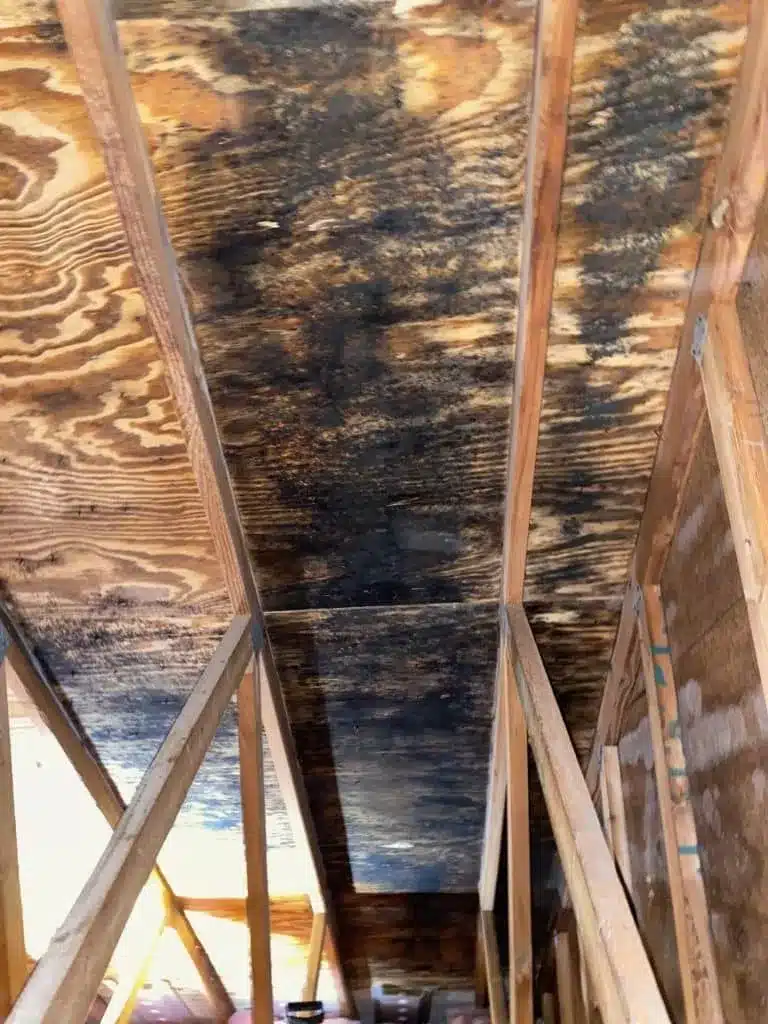
Some home inspectors are happy with us just killing the mold with InstaPURE dry fog remediation. as long as subsequent tests show levels are at healthy. Other home inspectors will insist that the mold be killed and then completely removed.
Mold Remediation in Two Hours
Scott: Well, one of the things is that we can be in and out of an attic in two hours with an after test. Most companies will charge a lot more and it will take more time to get the job done. If they’re, if it’s a realtor and they’re looking to turn around a house very quickly, we can be in and out of there in two hours.
Tim: Even with both processes, the killing the mold and…
Scott: No, no killing the mold two, two hours in and out. Right. Visual remediation or visual removal, that’s a whole different ball game that, that was six hours worth of spraying.
Tim: Oh, six hours. Yeah. Okay. So this is, this is a, what was it a full day or did it go over more than one day?
Scott: Well, it was very labor intensive.
Tim: Because you, so yeah, but
Scott: You basically have to take, you have to bring up some planks and put the planks on the, on the studs so you don’t fall through the roof, the ceiling <laugh>.
Tim: Yeah.
Scott: So each, each in between those studs is, you know, it is probably 20 or 30 minutes worth of work between the studs just spraying, pushing it back. It’s just very labor-intensive.
Tim: Right, so how long did the whole process take then? In this case?
Scott: I sprayed it one day and that took two hours and I came back the next and it was probably six, six, and a half hours.
Tim: Right. So you worked for your pennies on that one then?
Scott: Uh, yeah. Yeah. That, that was a tough one.
Does Dead Mold Have To Be Removed?
Tim: So, do people, if somebody’s got this level of problem, do they often sort of get it treated but not cleaned? Is that normal?
Scott: That’s all up to, up to the health inspector or health inspector that’s all up to the home inspector. There’s some home inspectors that are happy with doing, uh, dry fog remediation and after tests showing that the levels are at healthy levels and they’re happy with that. There are other home inspectors that want the mold killed and then removed, and then there’s the client. Sometimes they don’t care about the mold being removed, they just want it killed. And there are other ones that are very adamant about getting that staining off the attic itself.
Tim: So in this case then, it was discovered and required to be removed by the home inspector?
Scott: Correct.
Tim: Got it. Okay.
Scott: And I, I think it had to do with the realtor too, because they have to disclose it to the buyer.
Tim: Right. Alright. Anything else we should know about this project?
Scott: No, I think that covers it.
